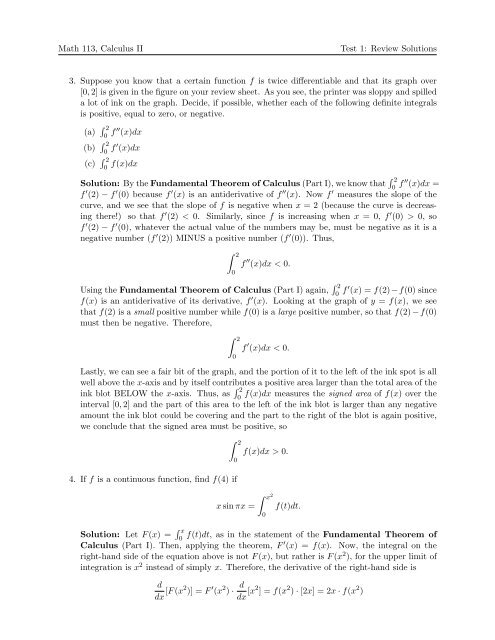Solutions to Practice Problems
Solutions to Practice Problems
Solutions to Practice Problems
Create successful ePaper yourself
Turn your PDF publications into a flip-book with our unique Google optimized e-Paper software.
Math 113, Calculus II<br />
Test 1: Review <strong>Solutions</strong><br />
3. Suppose you know that a certain function f is twice differentiable and that its graph over<br />
[0, 2] is given in the figure on your review sheet. As you see, the printer was sloppy and spilled<br />
a lot of ink on the graph. Decide, if possible, whether each of the following definite integrals<br />
is positive, equal <strong>to</strong> zero, or negative.<br />
(a) ∫ 2<br />
0 f ′′ (x)dx<br />
(b) ∫ 2<br />
0 f ′ (x)dx<br />
(c) ∫ 2<br />
0 f(x)dx<br />
Solution: By the Fundamental Theorem of Calculus (Part I), we know that ∫ 2<br />
0 f ′′ (x)dx =<br />
f ′ (2) − f ′ (0) because f ′ (x) is an antiderivative of f ′′ (x). Now f ′ measures the slope of the<br />
curve, and we see that the slope of f is negative when x = 2 (because the curve is decreasing<br />
there!) so that f ′ (2) < 0. Similarly, since f is increasing when x = 0, f ′ (0) > 0, so<br />
f ′ (2) − f ′ (0), whatever the actual value of the numbers may be, must be negative as it is a<br />
negative number (f ′ (2)) MINUS a positive number (f ′ (0)). Thus,<br />
∫ 2<br />
0<br />
f ′′ (x)dx < 0.<br />
Using the Fundamental Theorem of Calculus (Part I) again, ∫ 2<br />
0 f ′ (x) = f(2)−f(0) since<br />
f(x) is an antiderivative of its derivative, f ′ (x). Looking at the graph of y = f(x), we see<br />
that f(2) is a small positive number while f(0) is a large positive number, so that f(2) − f(0)<br />
must then be negative. Therefore,<br />
∫ 2<br />
0<br />
f ′ (x)dx < 0.<br />
Lastly, we can see a fair bit of the graph, and the portion of it <strong>to</strong> the left of the ink spot is all<br />
well above the x-axis and by itself contributes a positive area larger than the <strong>to</strong>tal area of the<br />
ink blot BELOW the x-axis. Thus, as ∫ 2<br />
0<br />
f(x)dx measures the signed area of f(x) over the<br />
interval [0, 2] and the part of this area <strong>to</strong> the left of the ink blot is larger than any negative<br />
amount the ink blot could be covering and the part <strong>to</strong> the right of the blot is again positive,<br />
we conclude that the signed area must be positive, so<br />
4. If f is a continuous function, find f(4) if<br />
∫ 2<br />
0<br />
x sin πx =<br />
f(x)dx > 0.<br />
∫ x 2<br />
0<br />
f(t)dt.<br />
Solution: Let F (x) = ∫ x<br />
0<br />
f(t)dt, as in the statement of the Fundamental Theorem of<br />
Calculus (Part I). Then, applying the theorem, F ′ (x) = f(x). Now, the integral on the<br />
right-hand side of the equation above is not F (x), but rather is F (x 2 ), for the upper limit of<br />
integration is x 2 instead of simply x. Therefore, the derivative of the right-hand side is<br />
d<br />
dx [F (x2 )] = F ′ (x 2 d<br />
) ·<br />
dx [x2 ] = f(x 2 ) · [2x] = 2x · f(x 2 )
















